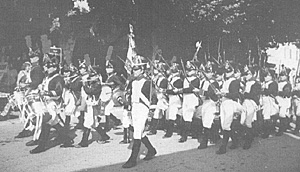Regulating Your Battalions?
The Command Problem
by David Commerford & Howie Muir, UK
| |
In particular, those “nippy battalions” reflect the remarkable properties players confer on individual units which permit battalions, regiments, even whole brigades, to perform like missiles, zooming across the table with precision guidance to strike opposing units in a manner so far removed from historical probability or possibility, as to be complete nonsense!
This may be entertaining, but does little to illuminate the historical factors or dynamics of the military age in play. The second design challenge is to cope with giants (i.e., players) who act as omniscient powers over all they survey, which would be just about everything from the scale height of somewhere between half a kilometre and a mile! By allowing them to see that which their tabletop counterparts
could not, players acquire an amount and range of visual information to guide their choices that a battlefield commander could only dream of having. More outlandishly, this broad player-awareness is immediately translated into perfect local knowledge on behalf of all their tabletop commands, resulting in that irresistible urge (familiar to us all) to fiddle about with the exact placement and orientation of each battalion.
Perhaps the most curious aspect of all this is that while new rule-designs have introduced some refinements to visibility and line of sight in recent years, the historical methods for battle-handling and maintaining orderly movement have more or less been ignored; ironically, if they were employed, they would do the job in a more accurate and effective way! (Our consideration of this subject may appear unabashedly Anglo-oriented, as one of us has the Queen’s English and other has…something else – and we’re both slower readers in other languages! – but the concepts this article explores were widely practiced throughout Europe.)
The Command Problem
In simple terms the question for every commander from the dawn of time has been. “How do I get this lot (My Army) to go over there and clobber that other lot (The Enemy Army) in some co-ordinated fashion?” Prior to the advent of the radio (some may argue that it has not helped that much, only allowing confusion to reign over a larger area), a hastily scrawled or snappy verbal order, coupled with fleet feet or a fast horse, were all that stood between victory and defeat.
To try and minimise the problem, militaries developed hierarchies and networks so that the limited spans of organisational control (not to be confused with anything wargamers do with tape measures) could be used to subdivide tasks. These system-architects hoped such structures would give some semblance of order to their respective armies by breaking down areas of responsibility into manageable chunks. Hence, by the Napoleonic era, we see Army Commanders giving broad orders to Corps Commanders, who either under direction, or at their discretion, giving orders to Divisional Commanders who then instruct Brigade Commanders to do the actual fighting via the direct employment of their Battalions/Regiments. Thus in crude terms we have Army Commanders determining the physical area of the
Corps activity, the Corps Commander doing the same for his Divisions and ultimately Brigadiers being responsible for the details of the people in harm’s way.
Now before all you keen types out there reach for your keyboards to tell us about so and so, at such and such a battle, directing a Brigade himself, or start describing the nuttier moments of Archduke Charles or dear old Blucher leading individual units into the fray, we are exploring norms here, not exceptions!
It’s the essential problem of getting multiple units, amounting to several thousand individuals, to move from Point A to Point B, arrive in the correct order at the required moment, and do what was required in unison, or as close as could be achieved, all while being shot at. Remember no radios or satellite communications available!
Regulating Your Battalions Tactical Processes and Simulation
|
 Over the years we’ve been wargaming, the lengths that players and rule-writers have gone to in order to control the actions of table top units, have been an endless source of fascination to us. Detailed written orders, diagrams, variations on a theme of command spans and radii, die-pips, card-drawing, charts and tables, all have been applied to the taxing task of keeping belligerent players honest with the connection between intention and tabletop action, to curb the “nippy little battalion” syndrome, and to limit the impact of the “1,000-foot general.”
Over the years we’ve been wargaming, the lengths that players and rule-writers have gone to in order to control the actions of table top units, have been an endless source of fascination to us. Detailed written orders, diagrams, variations on a theme of command spans and radii, die-pips, card-drawing, charts and tables, all have been applied to the taxing task of keeping belligerent players honest with the connection between intention and tabletop action, to curb the “nippy little battalion” syndrome, and to limit the impact of the “1,000-foot general.”